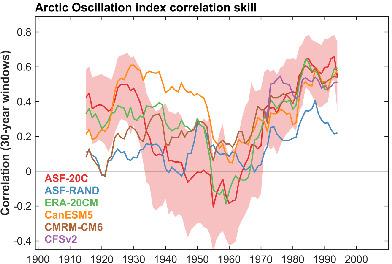当前位置:
X-MOL 学术
›
Q. J. R. Meteorol. Soc.
›
论文详情
Our official English website, www.x-mol.net, welcomes your feedback! (Note: you will need to create a separate account there.)
Assessing the robustness of multidecadal variability in Northern Hemisphere wintertime seasonal forecast skill
Quarterly Journal of the Royal Meteorological Society ( IF 8.9 ) Pub Date : 2020-08-14 , DOI: 10.1002/qj.3890 Christopher H. O'Reilly 1, 2 , Antje Weisheimer 2, 3 , David MacLeod 1 , Daniel J. Befort 1 , Tim Palmer 1
Quarterly Journal of the Royal Meteorological Society ( IF 8.9 ) Pub Date : 2020-08-14 , DOI: 10.1002/qj.3890 Christopher H. O'Reilly 1, 2 , Antje Weisheimer 2, 3 , David MacLeod 1 , Daniel J. Befort 1 , Tim Palmer 1
Affiliation

|
Recent studies have found evidence of multidecadal variability in Northern Hemisphere wintertime seasonal forecast skill. Here we assess the robustness of this finding by extending the analysis to a diverse set of ensemble atmospheric model simulations. These simulations differ in either the numerical model or type of initialisation and include atmospheric model experiments initialised with reanalysis data and free‐running atmospheric model ensembles. All ensembles are forced with observed sea‐surface temperatures (SSTs) and sea‐ice boundary conditions. Analysis of large‐scale Northern Hemisphere circulation indices over the Northern Hemisphere (namely the North Atlantic Oscillation, the Pacific/North American pattern and the Arctic Oscillation) reveals that in all ensembles there is larger correlation skill in late‐century periods than in mid‐century periods. Similar multidecadal variability in skill is found in a measure of total skill integrated over the whole extratropical region. Most of the differences in large‐scale circulation skill between the skilful late period (as well as the early period) and the less skilful mid‐century period seem to be due to a reduction in skill over the North Pacific and a disappearance of skill over North America and the North Atlantic. The results are robust across different models and different types of initialisation, indicating that the multidecadal variability in Northern Hemisphere winter skill is a robust feature of twentieth‐century climate variability. Multidecadal variability in skill therefore arises from the evolution of the observed SSTs, likely related to a weakened influence of the El Niño–Southern Oscillation on the predictable extratropical circulation signal during the middle of the twentieth century, and is evident in the signal‐to‐noise ratio of the different ensembles, particularly the larger ensembles.
中文翻译:

评估北半球冬季季节性预报技能的多年代际变化的稳健性
最近的研究发现北半球冬季季节预报技能存在多年代际变化的证据。在这里,我们通过将分析扩展到各种集成的大气模型模拟中来评估此发现的鲁棒性。这些模拟在数值模型或初始化类型上都不同,包括使用重新分析数据和自由运行的大气模型集合进行初始化的大气模型实验。所有集合都受到观测的海面温度(SST)和海冰边界条件的强迫。对北半球(即北大西洋涛动)的大规模北半球环流指数进行分析 太平洋/北美模式和北极涛动)表明,与世纪中叶相比,在所有合奏中,本世纪后期的关联技巧都更大。在整个温带地区整合的总技能量度中发现了类似的多年代际技能差异。在熟练的后期(以及早期)和不太熟练的本世纪中期之间,大规模循环技能的大多数差异似乎是由于北太平洋地区的技能减少和北美和北大西洋。结果在不同的模型和不同类型的初始化中均具有鲁棒性,表明北半球冬季技能的多年代际变化是20世纪气候变化的强大特征。
更新日期:2020-08-14
中文翻译:

评估北半球冬季季节性预报技能的多年代际变化的稳健性
最近的研究发现北半球冬季季节预报技能存在多年代际变化的证据。在这里,我们通过将分析扩展到各种集成的大气模型模拟中来评估此发现的鲁棒性。这些模拟在数值模型或初始化类型上都不同,包括使用重新分析数据和自由运行的大气模型集合进行初始化的大气模型实验。所有集合都受到观测的海面温度(SST)和海冰边界条件的强迫。对北半球(即北大西洋涛动)的大规模北半球环流指数进行分析 太平洋/北美模式和北极涛动)表明,与世纪中叶相比,在所有合奏中,本世纪后期的关联技巧都更大。在整个温带地区整合的总技能量度中发现了类似的多年代际技能差异。在熟练的后期(以及早期)和不太熟练的本世纪中期之间,大规模循环技能的大多数差异似乎是由于北太平洋地区的技能减少和北美和北大西洋。结果在不同的模型和不同类型的初始化中均具有鲁棒性,表明北半球冬季技能的多年代际变化是20世纪气候变化的强大特征。



























 京公网安备 11010802027423号
京公网安备 11010802027423号